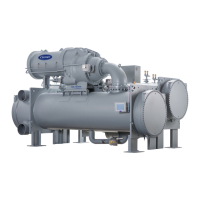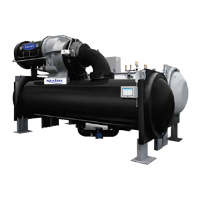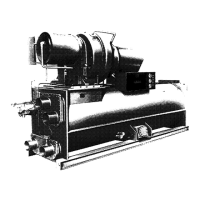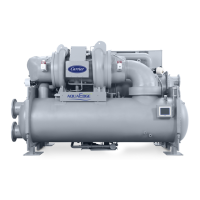69
PREVENTIVE MAINTENANCE
To maximize uptime it is recommended to perform regular pre-
ventive maintenance. Annual preventative maintenance includes
the following primary tasks:
• Visual inspection of all components accessible from the
front of the module
• Resistance checks on power components
• Power-supply voltage level checks
• General cleaning and maintenance
• Tightness checks on all accessible power connections
See Table 9 to understand the maintenance tasks, codes, and de-
scriptions that are detailed in Table 10.
Periodic Inspection
Periodically inspect industrial control equipment. Base inspection
intervals on the environmental and operating conditions and adjust
the intervals as necessary. An initial inspection within 3 to 4
months after installation is suggested.
Contamination
If inspection reveals that dust, dirt, moisture, or other contamina-
tion has reached the control equipment, the cause must be re-
moved. Contamination can indicate an incorrectly selected or inef-
fective enclosure, unsealed enclosure openings (conduit or other),
or incorrect operating procedures. Replace any improperly select-
ed enclosure with one that is suitable for the environmental condi-
tions. Replace any damaged or cracked elastomer seals and repair
or replace any other damaged or malfunctioning parts (for exam-
ple, hinges and fasteners). Dirty, wet, or contaminated control de-
vices must be replaced. Compressed air is not recommended for
cleaning because it can displace dirt, dust, or debris into other
parts or equipment, or damage delicate parts.
PowerFlex 755T products with XT use dielectric grease to protect
critical connections from the effects of corrosive gases. When you
disconnect or reconnect a greased connection, always inspect for
dust, dirt, conductive debris or other contaminants. If contamina-
tion is found, thoroughly clean receiving surfaces and re-apply di-
electric grease.
Blowers and Fans
: Inspect blowers and fans that are used for
forced air cooling. Replace any that have bent, chipped, or missing
blades, or if the shaft does not turn freely. Apply power momentar-
ily to check operation. If the unit does not operate, check and re-
place wiring, fuse, or blower or fan motor as appropriate. Clean or
change air filters as recommended in the product manual. Also,
clean the fins of heat exchangers so convection cooling is not
impaired.
Operating Mechanisms
: Check for proper function and freedom
from sticking or binding. Replace any broken, deformed, or badly
worn parts or assemblies according to individual product renewal
parts lists. Check for and re-tighten securely any loose fasteners.
Lubricate if specified in individual product instructions.
Contacts
: Check contacts for excessive wear and dirt accumula-
tion. Wipe contacts with a soft cloth, if necessary, to remove dirt.
Discoloration and slight pitting does not harm contacts. Do not file
contacts — this action shortens the life of the contact. Do not use
contact spray cleaners because residue on magnet pole faces or in
operating mechanisms can cause sticking, and on contacts can in-
terfere with electrical continuity. Replace contacts only after the
silver has become badly worn. Always replace contacts in com-
plete sets to avoid misalignment and uneven contact pressure.
Terminals
: Loose connections in power circuits can cause over-
heating that can lead to equipment malfunction or failure. Loose
connections in control circuits can cause control malfunctions.
Loose bond or ground connections can increase hazards of electri-
cal shock and contribute to electromagnetic interference (EMI).
Check the tightness of all terminals and bus bar connections and
torque any loose connections properly. Infrared technology can be
used to check for hot (high resistance/loose) connections during
periodic maintenance. Replace any parts or wiring that is damaged
by overheating, and any broken wires or bond straps.
Coils
: If a coil is overheated (contains cracked, melted, or burned
insulation), it must be replaced. In that event, check for and correct
over-voltage or under-voltage conditions, which can cause coil
failure. Be sure to clean any residues of melted coil insulation
from other parts of the device or replace such parts.
High-Voltage Testing
: Do not perform high-voltage insulation
resistance and dielectric withstanding voltage tests to check the
VFD health. The VFD must be disconnected prior to undertaking
any motor tests.
Table 9 — Maintenance Tasks, Codes, and Descriptions
CODE TASK DESCRIPTION
I Inspect
Inspect the component for signs of excessive accumulation of dust, dirt, or external damage, For example, inspect the filters/fan inlet screens for debris that can
block the airflow path.
C Clean Clean the components that can be reused, specifically the door-mounted air filters and fan inlet screens.
M Maintain This type of maintenance task can include an inductance test of line reactors/DC links, or a full test of an isolation transformer, and so on.
RReplace
This component has reached its mean operational life. Replace the component to decrease the chance of failure. It is likely that components can exceed the
designed life in the drive, but component life is dependent on many factors including usage and heat. Use the predictive maintenance parameters to determine a
replacement schedule for components in shaded table rows.
Rv Review
A discussion with Rockwell Automation personnel is recommended to help determine whether any enhancements/changes made to the drive hardware and
control could benefit the application.

